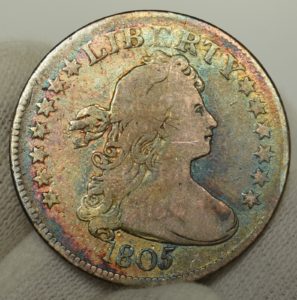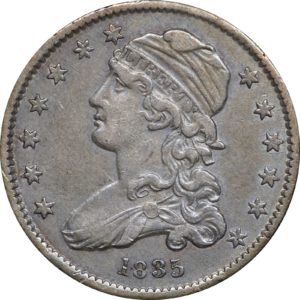The Early Quarters: The Draped and Capped Bust


The year is 1791 and US Congress has just passed a joint resolution calling for the creation of a national mint. A year later, its establishment was authorized by the Coinage Act of 1792. It took two years before coins were struck, with the Flowing Hair dollar being the first coin produced.
So much was the dislike for the coin that a new design was called for.
The Draped Bust Quarter
Mint Director Henry DeSaussure asked Gilbert Stuart, a known portrait artist, to create a design for new coins. Stuart reportedly used a Philadelphia socialite of great beauty called Ann Willing Bingham as a model for the portrait to be featured on the obverse of the coin. Unfortunately, the actual representation on the coin didn’t do Mrs. Bingham any justice. But nevertheless, the coins were issued beginning in 1796.
Draped Bust Quarter Design
The Draped Bust quarter features a portrait on the obverse that was circled by 15 stars. The words LIBERTY form on arch above while the date is located below. The reverse of the coin shows an eagle with clouds and a wreath of olive and palm branches. Encircling the wreath are the words UNITED STATES OF AMERICA. This particular design became known as Draped Bust, Small Eagle and was only produced in small amounts.
In fact, the quarter didn’t appear again in US coinage until 1804 because other coins offered the same purchasing power. When it reappeared, the Dropped Bust coin now featured a larger eagle based on the Great Seal of the United States. The image of Liberty remained the same, but the number of stars were reduced to 13 to represent the original states. This design was known as the Draped Bust, Heraldic Eagle.
The eagle in the Heraldic Eagle quarter had a shield superimposed on its breast while a banner in its beak bore the words E PLURIBUS UNUM. It also grasps a sheaf of arrows and an olive branch, two symbolic items. This design was in production for just four years.
Quarters never really gained a strong footing, and production was shelved again after the production of 1807 coins. The coins would make an appearance again in 1815 sporting a new design.
The Capped Bust Quarter
Chaos in Europe brought many new settlers to the United States. Among them was a German engraver called John Reich, who applied for a job at the US Mint and was hired in 1807. The Capped Bust quarter is his design.
Capped Bust Quarter Design
Reich injected Europe into his design. The obverse of the coin shows a quite buxom Liberty surrounded by 13 stars with the date placed below. She is wearing a mob cap inscribed with the word LIBERTY.
The reverse of the coin features an eagle with its wings outstretched, perched on a branch, and holding three arrows. The Union Shield is also on its breast and the words E PLURIBUS UNUM written on a scroll above it. The words UNITED STATES OF AMERICA appear on the border.
Capped Bust quarters were produced for 11 years, but only in small quantities. The end of its production also marked the end for the first building of the Philadelphia Mint. A new building was being constructed and with that came a new design by Mint Engraver William Kneass.
The Capped Bust, Small Diameter quarter was produced in 1831. Like its name suggests, it is smaller than its predecessor and comes without the motto E PLURIBUS UNUM. The Small Diameter coin was only struck for eight years, but all in the Philadelphia Mint. What makes this particular coin special is the mechanical improvements it made, which became the basis of all US coins created after 1836.
Although considered “advanced”, the coin would stop being produced in 1838 to make way for a new Seated Liberty Design by Christian Gobrecht.
